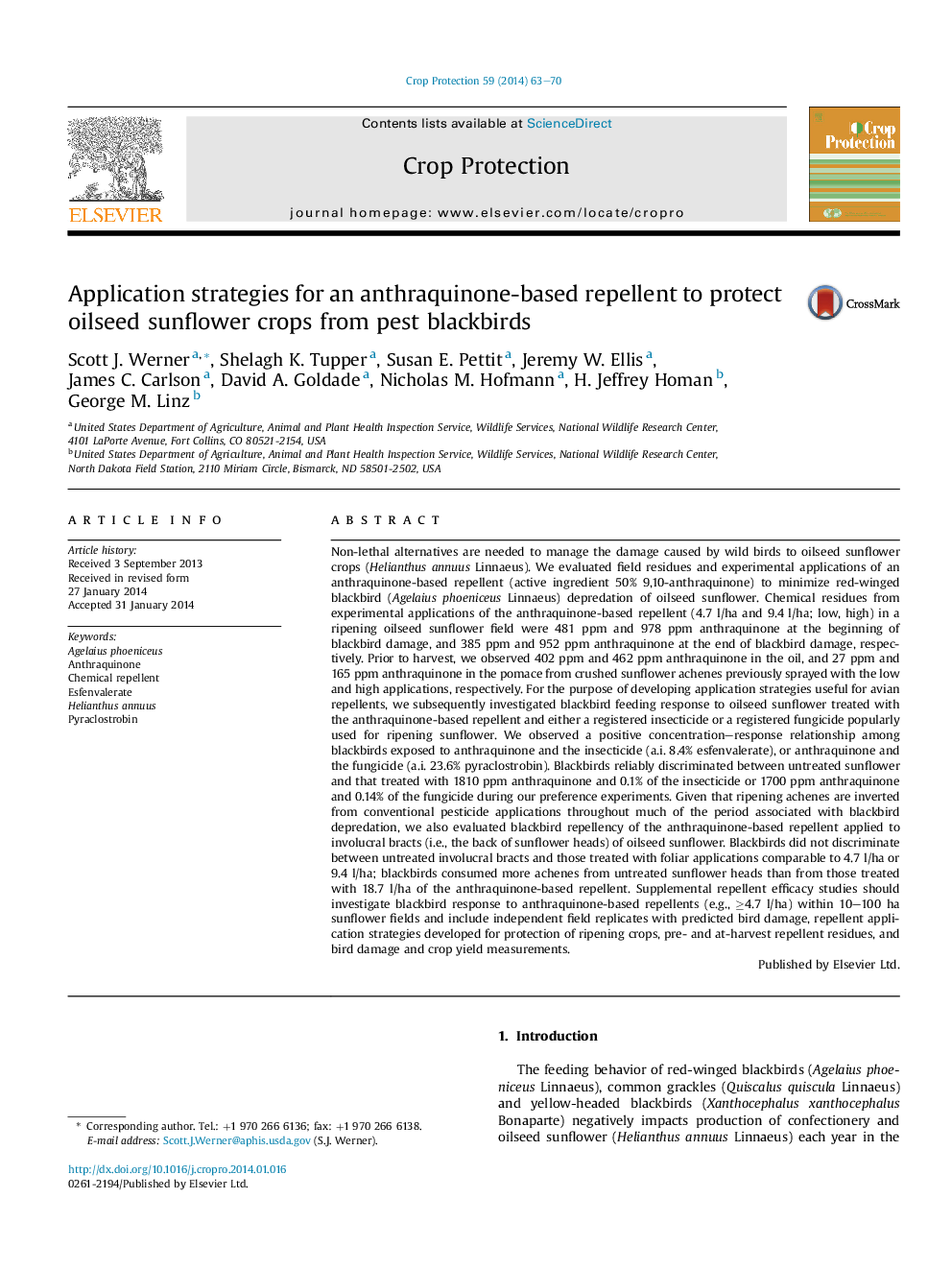| کد مقاله | کد نشریه | سال انتشار | مقاله انگلیسی | نسخه تمام متن |
|---|---|---|---|---|
| 6373744 | 1624328 | 2014 | 8 صفحه PDF | دانلود رایگان |
عنوان انگلیسی مقاله ISI
Application strategies for an anthraquinone-based repellent to protect oilseed sunflower crops from pest blackbirds
ترجمه فارسی عنوان
استراتژی های کاربردی برای یک ماده ضد انعقاد بر روی آنتوراکینون برای محافظت از محصولات آفتابگردان روغن آفتابگردان
دانلود مقاله + سفارش ترجمه
دانلود مقاله ISI انگلیسی
رایگان برای ایرانیان
کلمات کلیدی
موضوعات مرتبط
علوم زیستی و بیوفناوری
علوم کشاورزی و بیولوژیک
علوم زراعت و اصلاح نباتات
چکیده انگلیسی
Non-lethal alternatives are needed to manage the damage caused by wild birds to oilseed sunflower crops (Helianthus annuus Linnaeus). We evaluated field residues and experimental applications of an anthraquinone-based repellent (active ingredient 50% 9,10-anthraquinone) to minimize red-winged blackbird (Agelaius phoeniceus Linnaeus) depredation of oilseed sunflower. Chemical residues from experimental applications of the anthraquinone-based repellent (4.7 l/ha and 9.4 l/ha; low, high) in a ripening oilseed sunflower field were 481 ppm and 978 ppm anthraquinone at the beginning of blackbird damage, and 385 ppm and 952 ppm anthraquinone at the end of blackbird damage, respectively. Prior to harvest, we observed 402 ppm and 462 ppm anthraquinone in the oil, and 27 ppm and 165 ppm anthraquinone in the pomace from crushed sunflower achenes previously sprayed with the low and high applications, respectively. For the purpose of developing application strategies useful for avian repellents, we subsequently investigated blackbird feeding response to oilseed sunflower treated with the anthraquinone-based repellent and either a registered insecticide or a registered fungicide popularly used for ripening sunflower. We observed a positive concentration-response relationship among blackbirds exposed to anthraquinone and the insecticide (a.i. 8.4% esfenvalerate), or anthraquinone and the fungicide (a.i. 23.6% pyraclostrobin). Blackbirds reliably discriminated between untreated sunflower and that treated with 1810 ppm anthraquinone and 0.1% of the insecticide or 1700 ppm anthraquinone and 0.14% of the fungicide during our preference experiments. Given that ripening achenes are inverted from conventional pesticide applications throughout much of the period associated with blackbird depredation, we also evaluated blackbird repellency of the anthraquinone-based repellent applied to involucral bracts (i.e., the back of sunflower heads) of oilseed sunflower. Blackbirds did not discriminate between untreated involucral bracts and those treated with foliar applications comparable to 4.7 l/ha or 9.4 l/ha; blackbirds consumed more achenes from untreated sunflower heads than from those treated with 18.7 l/ha of the anthraquinone-based repellent. Supplemental repellent efficacy studies should investigate blackbird response to anthraquinone-based repellents (e.g., â¥4.7 l/ha) within 10-100 ha sunflower fields and include independent field replicates with predicted bird damage, repellent application strategies developed for protection of ripening crops, pre- and at-harvest repellent residues, and bird damage and crop yield measurements.
ناشر
Database: Elsevier - ScienceDirect (ساینس دایرکت)
Journal: Crop Protection - Volume 59, May 2014, Pages 63-70
Journal: Crop Protection - Volume 59, May 2014, Pages 63-70
نویسندگان
Scott J. Werner, Shelagh K. Tupper, Susan E. Pettit, Jeremy W. Ellis, James C. Carlson, David A. Goldade, Nicholas M. Hofmann, H. Jeffrey Homan, George M. Linz,
